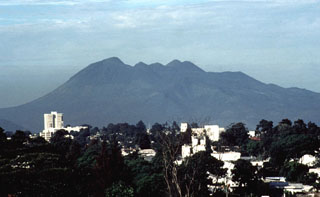Report on Pacaya (Guatemala) — February 1988
Scientific Event Alert Network Bulletin, vol. 13, no. 2 (February 1988)
Managing Editor: Lindsay McClelland.
Pacaya (Guatemala) Frequent Strombolian explosions; lava flow still active
Please cite this report as:
Global Volcanism Program, 1988. Report on Pacaya (Guatemala) (McClelland, L., ed.). Scientific Event Alert Network Bulletin, 13:2. Smithsonian Institution. https://doi.org/10.5479/si.GVP.SEAN198802-342110
Pacaya
Guatemala
14.382°N, 90.601°W; summit elev. 2569 m
All times are local (unless otherwise noted)
The geologic team that visited Tacaná on 27-28 January climbed Pacaya on 31 January. From the summit of Cerro Chino at 1330, they saw frequent ejections of steam and ash, and, less frequently, bluish gas plumes emerging from MacKenney Crater.
Periodic observations of Pacaya's activity were made during February by scientists listed below. Strombolian explosions ejected blocks and incandescent bombs from MacKenney Crater every few minutes, accompanied by detonations. During the evening of 13 February, detonations were audible from Guatemala City, 25 km NNE. Although the SW flank lava flow was not visible from Pacaya's summit, observation of nighttime incandescence on 22 February (from the road below San Vicente Pacaya) indicated that it remained active.
Geological Summary. Eruptions from Pacaya are frequently visible from Guatemala City, the nation's capital. This complex basaltic volcano was constructed just outside the southern topographic rim of the 14 x 16 km Pleistocene Amatitlán caldera. A cluster of dacitic lava domes occupies the southern caldera floor. The post-caldera Pacaya massif includes the older Pacaya Viejo and Cerro Grande stratovolcanoes and the currently active Mackenney stratovolcano. Collapse of Pacaya Viejo between 600 and 1,500 years ago produced a debris-avalanche deposit that extends 25 km onto the Pacific coastal plain and left an arcuate scarp inside which the modern Pacaya volcano (Mackenney cone) grew. The NW-flank Cerro Chino crater was last active in the 19th century. During the past several decades, activity has consisted of frequent Strombolian eruptions with intermittent lava flow extrusion that has partially filled in the caldera moat and covered the flanks of Mackenney cone, punctuated by occasional larger explosive eruptions that partially destroy the summit.
Information Contacts: James Vallance, Jorge Girón, Francisco Alvarez, Lee Siebert, and Gerardo Sánchez Rubio, Estación Regional del Centro, Instituto de Geología, UNAM, Guanajuato, México; A. MacKenney, Guatemala City.

